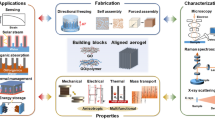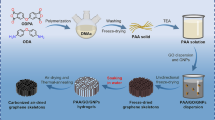Abstract
Paraffin-based nanocomposites are widely used in the energy, microelectronics and aerospace industry as thermal energy storage materials due to their outstanding thermophysical properties. This paper investigates the effects of functionalization on thermal properties of graphene/n-octadecane nanocomposite during phase transition by using non-equilibrium molecular dynamics simulation. Different composite systems containing pristine graphene and graphene functionalized by hydroxyl, carboxyl and ethyl are constructed and studied. The results indicate that the thermal properties like diffusion coefficient, phase change temperature, heat capacity and thermal conductivity can be changed by both the functional types and functional coverage. Comparing with the unfunctionalized system, the system functionalized by ethyl obtained a 10 K increase in phase change temperature, a 12% increase in isobaric heat capacity at 300 K and a 59.8% increase in thermal conductivity at 320 K, and these values are larger than that of the systems functionalized by carboxyl and ethyl. The present findings provide a better understanding of the thermal mechanism of graphene/paraffin nanocomposites and effective guidance for improving their thermophysical properties.













Similar content being viewed by others
References
Li Z, Wu Y, Zhuang B, Zhao X, Tang Y, Ding X, Chen K (2017) Preparation of novel copper-powder-sintered frame/paraffin form-stable phase change materials with extremely high thermal conductivity. Appl Energy 206:1147–1157
Lin C, Rao Z (2017) Thermal conductivity enhancement of paraffin by adding boron nitride nanostructures: a molecular dynamics study. Appl Therm Eng 110:1411–1419
Li Q, Yu Y, Liu Y, Liu C, Lin L (2017) Thermal properties of the mixed n-octadecane/Cu nanoparticle nanofluids during phase transition: a molecular dynamics study. Materials 10:38. https://doi.org/10.3390/ma10010038
Li Q, Guo Y, Li W, Qiu S, Zhu C, Wei X, Chen M, Liu C, Liao S, Gong Y, Mishra AK, Liu L (2014) Ultrahigh thermal conductivity of assembled aligned multilayer graphene/epoxy composite. Chem Mater 26:4459–4465
Zhang P, Yuan P, Jiang X, Zhai S, Zeng J, Xian Y, Qin H, Yang D (2017) A Theoretical review on interfacial thermal transport at the nanoscale. Small 14:1702769. https://doi.org/10.1002/smll.201702769
Huang YR, Chuang PH, Chen CL (2015) Molecular-dynamics calculation of the thermal conduction in phase change materials of graphene paraffin nanocomposites. Int J Heat Mass Transf 91:45–51
Mehrali M, Latibari ST, Mehrali M, Metselaar HSC, Silakhori M (2013) Shape-stabilized phase change materials with high thermal conductivity based on paraffin/graphene oxide composite. Energy Convers Manag 67:275–282
Babaei H, Keblinski P, Khodadadi JM (2013) Thermal conductivity enhancement of paraffins by increasing the alignment of molecules through adding CNT/graphene. Int J Heat Mass Transf 58:209–216
Wang M, Hu N, Zhou L, Yan C (2015) Enhanced interfacial thermal transport across graphene-polymer interfaces by grafting polymer chains. Carbon 85:414–421
Hopkins PE, Baraket M, Barnat EV, Beechem TE, Kearney SP, Duda JC, Robinson JT, Walton SG (2012) Manipulating thermal conductance at metal–graphene contacts via chemical functionalization. Nano Lett 12:590–595
Wang Y, Yang C, Cheng Y, Zhang YY (2015) A molecular dynamics study on thermal and mechanical properties of graphene–paraffin nanocomposites. RSC Adv 5:82638–82644
Jiang T, Zhang X, Vishwanath S, Mu X, Kanzyuba V, Sokolov DA, Ptasinska S, Go DB, Xing HG, Luo T (2016) Covalent bonding modulated graphene–metal interfacial thermal transport. Nanoscale 8:10993–11001
Wang Y, Yang C, Pei Q, Zhang Y (2016) Some aspects of thermal transport across the interface between graphene and epoxy in nanocomposites. ACS Appl Mater Interfaces 8:8272–8279
Zabihi Z, Araghi H (2016) Effect of functional groups on thermal conductivity of graphene/paraffin nanocomposite. Phys Lett A 380:3828–3831
Shen X, Wang Z, Wu Y, Liu X, Kim J (2016) Effect of functionalization on thermal conductivities of graphene/epoxy composites. Carbon 108:412–422
Sun H (1998) COMPASS: an ab initio force-field optimized for condensed-phase applications overview with details on alkane and benzene compounds. J Phys Chem B 102:7338–7364
Arash B, Wang Q, Varadan VK (2008) Mechanical properties of carbon nanotube/polymer composites. Polym Mater Sci Eng 4:6479. https://doi.org/10.1038/srep06479
Zheng Q, Geng Y, Wang S, Li Z, Kim J (2010) Effects of functional groups on the mechanical and wrinkling properties of graphene sheets. Carbon 48:4315–4322
Shen X, Wang Z, Wu Y, Liu X, He Y, Kim J (2016) Multilayer graphene enables higher efficiency in improving thermal conductivities of graphene/epoxy composites. Nano Lett 16:3585–3593
Andersen HC (1980) Molecular dynamics simulations at constant pressure and/or temperature. J Chem Phys 72:2384–2393
Berendsen HJC, Postma JPM, Gunsteren WFV, Dinola A, Haak JR (1998) Molecular dynamics with coupling to an external bath. J Chem Phys 81:3684–3690
Karasawa N, Goddard WAI (1992) Force fields, structures, and properties of poly (vinylidene fluoride) crystals. Macromolecules 25:7268–7281
Ewald PP (1921) Evaluation of optical and electrostatics lattice potentials. Ann Phys N Y 64:253–287
Makrodimitri ZA, Unruh DJM, Economou IG (2011) Molecular simulation of diffusion of hydrogen, carbon monoxide, and water in heavy n-alkanes. J Phys Chem B 115:1429–1439
Hofmann D, Fritz L, Ulbrich J, Schepers C, Böhning M (2000) Detailed-atomistic molecular modeling of small molecule diffusion and solution processes in polymeric membrane materials. Macromol Theor Simul 9:293–327
Yu S, Wang X, Wu D (2014) Microencapsulation of n-octadecane phase change material with calcium carbonate shell for enhancement of thermal conductivity and serving durability: synthesis, microstructure, and performance evaluation. Appl Energy 114:632–643
Liu X, Rao Z (2017) Thermal diffusion and phase transition of n-octadecane as thermal energy storage material on nanoscale copper surface: a molecular dynamics study. J Energy Inst. https://doi.org/10.1016/j.joei.2017.10.011
Yang S, Qu J (2012) Computing thermomechanical properties of crosslinked epoxy by molecular dynamic simulations. Polymer 53:4806–4817
Allen MP, Tildesley DJ (1987) Computer simulation of liquids. Clarendon Press, New York
Rao Z, Wang S, Peng F (2013) Self diffusion and heat capacity of n-alkanes based phase change materials: a molecular dynamics study. Int J Heat Mass Transf 64:581–589
Miltenburg JCV, Oonk HAJ, Metivaud V (1999) Heat capacities and derived thermodynamic functions of n-nonadecane and n-eicosane between 10 and 390 K. J Chem Eng Data 44:715–720
Lv C, Xue Q, Xia D, Ma M, Xie J, Chen H (2010) Effect of chemisorption on the interfacial bonding characteristics of graphene–polymer composites. J Phys Chem C 114:6588–6594
Zhang T, Gans-Forrest AR, Lee E, Zhang X, Qu C, Pang Y, Sun F, Luo T (2016) Role of hydrogen bonds in thermal transport across hard/soft material interfaces. ACS Appl Mater Interfaces 8:33326–33334
Shiu S, Tsai J (2014) Characterizing thermal and mechanical properties of graphene/epoxy nanocomposites. Compos Part B Eng 56:691–697
Das B, Eswar PK, Ramamurty U, Rao CN (2009) Nano-indentation studies on polymer matrix composites reinforced by few-layer graphene. Nanotechnology 20:125705. https://doi.org/10.1088/0957-4484/20/12/125705
Shi JN, Ger MD, Liu YM, Fan YC, Wen NT, Lin CK, Pu NW (2013) Improving the thermal conductivity and shape-stabilization of phase change materials using nanographite additives. Carbon 51:365–372
Sun F, Zhang T, Jobbins MM, Guo Z, Zhang X, Zheng Z, Tang D, Ptasinska S, Luo T (2014) Molecular bridge enables anomalous enhancement in thermal transport across hard-soft material interfaces. Adv Mater 26:6093–6099
Acknowledgements
The author(s) disclosed receipt of the following financial support for the research, authorship, and/or publication of this article: The authors acknowledge the financial support provided by National Natural Science Foundation of China (Project No. 51506033), MIIT Key Laboratory of Thermal Control of Electronic Equipment (Grant No. 2017JJA001), Innovation Project of GUET Graduate Education (Grant No. 2018YJCX03), Guangxi Natural Science Foundation (Grant No. 2017JJA160108), and GUET Excellent Graduate Thesis Program (Grant No. 16YJPYSS03).
Author information
Authors and Affiliations
Corresponding author
Rights and permissions
About this article
Cite this article
Yuan, P., Zhang, P., Liang, T. et al. Effects of functionalization on energy storage properties and thermal conductivity of graphene/n-octadecane composite phase change materials. J Mater Sci 54, 1488–1501 (2019). https://doi.org/10.1007/s10853-018-2883-2
Received:
Accepted:
Published:
Issue Date:
DOI: https://doi.org/10.1007/s10853-018-2883-2




